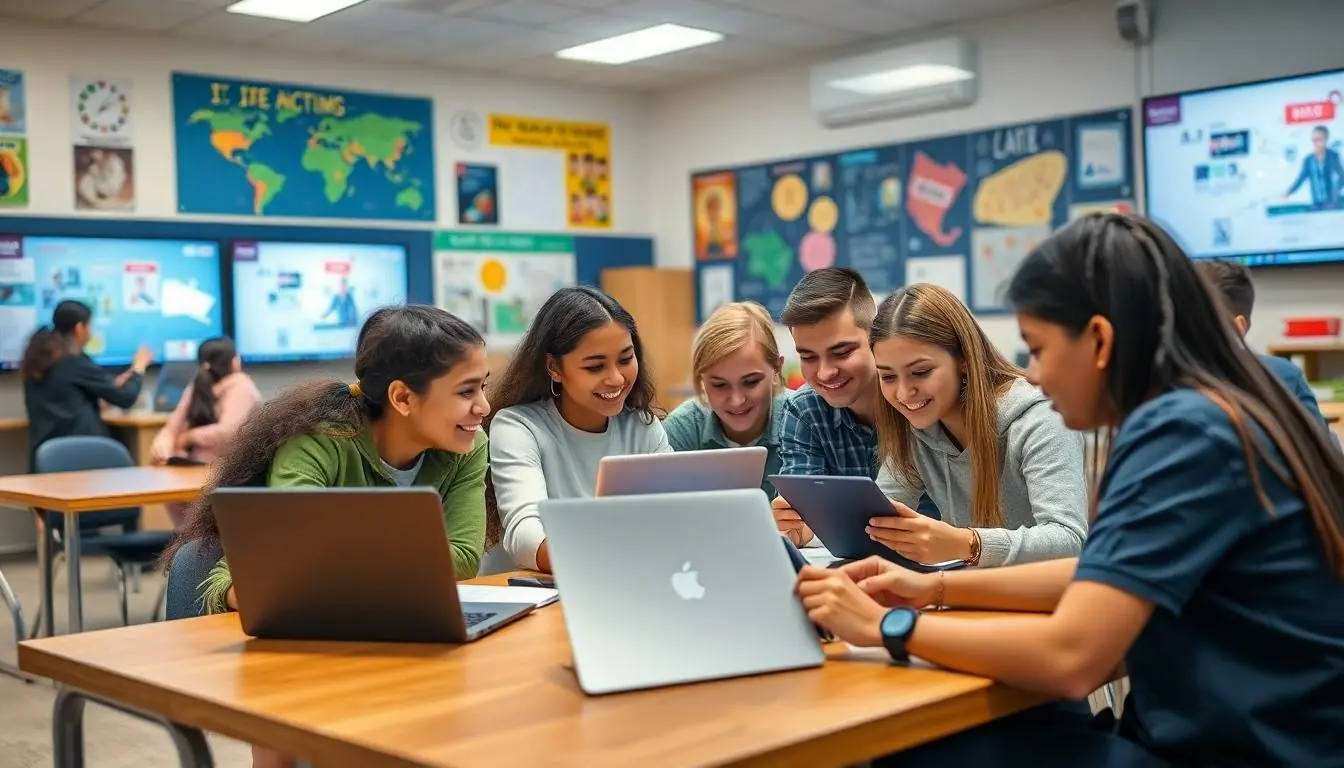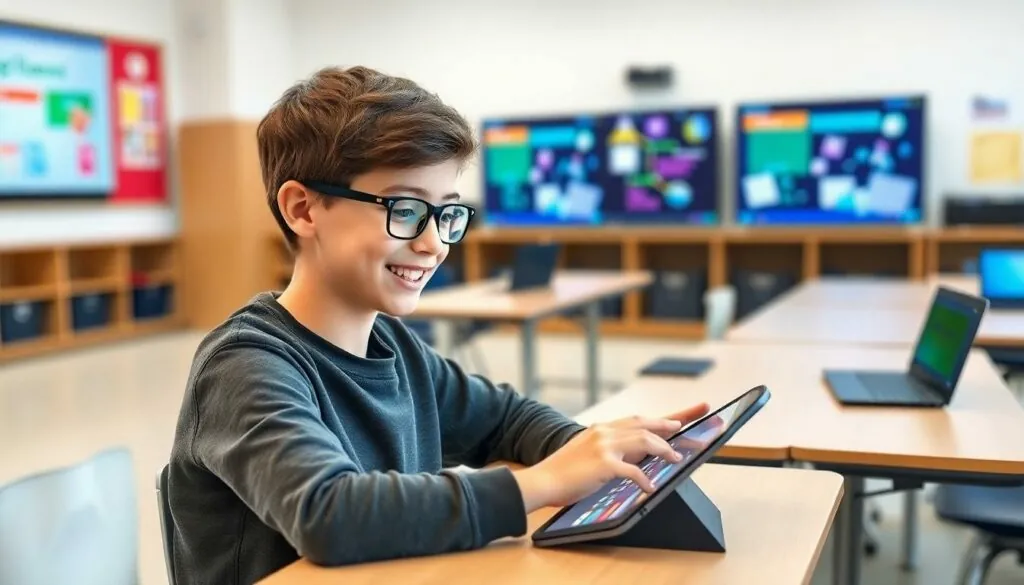In today’s fast-paced world, technology has transformed education from chalkboards and textbooks to interactive screens and virtual classrooms. Imagine a classroom where students can explore the universe through augmented reality or collaborate on projects with peers halfway around the globe—all from the comfort of their homes. It sounds like something out of a sci-fi movie, but it’s the reality of modern education.
Table of Contents
ToggleOverview of Technology Used in Education Today
Technology in education includes a variety of tools that enhance learning experiences. Online learning platforms provide access to courses and resources globally. These platforms, such as Coursera and Khan Academy, offer flexibility that traditional classrooms cannot.
Interactive whiteboards replace traditional chalkboards, allowing for dynamic presentations. This type of technology fosters interaction during lessons, encouraging student participation. Tablets and laptops also play a vital role, providing students with access to digital textbooks and educational apps.
Learning management systems streamline administrative tasks for educators. Systems like Moodle and Canvas simplify course management and grading, saving time and enhancing communication. Teachers can easily track student progress and provide personalized feedback.
Virtual and augmented reality technologies create immersive learning environments. Students can explore historical events or complex scientific concepts in ways that textbooks cannot replicate. These experiences lead to deeper understanding and retention of information.
Collaboration tools such as Google Workspace facilitate teamwork among students. Shared documents and applications enable real-time collaboration on projects, promoting essential skills for the workforce. Technology also allows for global communication, connecting students with peers around the world.
Gamification adds an engaging element to education. Educational games encourage competition and motivation, making learning fun. Incorporating game-based elements can improve student engagement and achievement.
Overall, technology creates a richer, more interactive educational landscape. It transforms traditional methodologies, offering innovative solutions for diverse learning needs. By leveraging these tools, educators can enhance the overall quality of education and prepare students for success in a rapidly changing world.
Types of Technology in Educational Settings

Technology reshapes educational environments, driving innovation and enhancing the learning experience. Key types influence how students and educators interact.
Digital Classrooms
Digital classrooms integrate technology to create interactive learning spaces. Tablets and laptops provide students with instant access to information and resources. Teachers utilize software tools for real-time feedback and assessment. Online platforms enable collaborative projects, allowing students to work together regardless of location. Virtual classrooms facilitate discussions through video conferencing, cultivating a global classroom atmosphere.
Learning Management Systems (LMS)
Learning management systems streamline the educational process by organizing content and resources. Platforms like Moodle and Canvas enable instructors to create organized course structures. Students can track their progress, access materials at their convenience, and submit assignments digitally. Personalized learning experiences arise as educators provide tailored feedback. Analytics tools within LMS allow for insights on student engagement and performance.
Interactive Tools and Applications
Interactive tools and applications enrich the classroom experience through dynamic engagement. Educators leverage tools like Kahoot and Nearpod to gamify lessons, making learning enjoyable. Visual aids offered by apps like Google Slides enhance presentations and retention. Simulations and virtual labs enable practical experimentation, deepening understanding. Collaboration through shared documents fosters communication and teamwork skills among peers.
Benefits of Technology in Education
Technology significantly enhances the educational experience by promoting engagement and deeper understanding among students. It opens new avenues for learning through various innovative tools and methods.
Enhanced Learning Experiences
Virtual reality and augmented reality immerse students in their subjects. Engaging simulations allow learners to explore complex concepts interactively. Interactive tools, like educational apps and platforms, facilitate real-time feedback and collaboration. Gamified lessons increase retention by making learning enjoyable. These methods cater to diverse learning styles, ensuring that all students find pathways to succeed.
Accessibility and Inclusivity
Technology breaks down barriers for students with disabilities. Online resources support varied needs, ensuring everyone can participate in education. Apps that provide text-to-speech and speech-to-text capabilities enhance learning for individuals with different challenges. Flexible online platforms offer options for remote learning, making education more accessible to those in rural areas. Increased availability of materials in multiple languages fosters inclusivity, promoting a diverse learning environment.
Challenges Faced in Implementing Technology
Integrating technology in education comes with several challenges that can hinder its effectiveness.
Digital Divide
The digital divide remains a significant issue. Students in rural or low-income areas often lack access to reliable internet and devices. This gap can lead to inequitable learning opportunities, leaving some students behind. According to a report from the Pew Research Center, nearly 15% of U.S. households with school-age children lack high-speed internet access. Bridging this gap is essential for ensuring all students benefit from modern educational tools.
Resistance to Change
Resistance to change also hampers progress. Educators accustomed to traditional teaching methods may hesitate to adopt new technology. Training is often insufficient, leading to frustration and underutilization of resources. A study by the Education Week Research Center found that over 60% of teachers reported inadequate professional development for integrating technology. Overcoming this resistance requires ongoing support and clear communication about the advantages of adopting innovative solutions.
Future Trends in Educational Technology
Emerging educational technologies will play a crucial role in shaping the future of learning environments. Artificial intelligence (AI) is set to personalize learning experiences through adaptive learning systems that adjust to individual student needs. With AI, data analysis provides insights into student performance, helping educators tailor their approaches.
Augmented reality (AR) and virtual reality (VR) tools will gain further traction, allowing students to engage in immersive experiences that enhance understanding of complex subjects. This technology creates scenarios that traditional methods cannot replicate, making learning both memorable and effective.
Cloud computing will continue to facilitate collaboration among students and educators. Accessing resources from anywhere promotes teamwork across different locations, enriching group projects and discussions. Many institutions will embrace blended learning models that combine in-person instruction with online elements, maximizing flexibility for students.
Mobile learning will become increasingly significant, as smartphones and tablets will allow students to learn anytime, anywhere. As a result, educational apps that gamify learning will thrive, capturing student interest and motivation. Research indicates that 70% of students prefer game-based learning approaches, showcasing the effectiveness of this method in education.
Teacher training programs will evolve to include technology integration, ensuring educators feel confident in using new tools. Ongoing professional development will become essential for successful implementation of innovative technologies in classrooms.
Accessibility technologies will continue to advance, providing support for students with disabilities. Tools that offer features such as speech-to-text and text-to-speech will ensure all students can engage fully in the learning process. Inclusivity in education will be enhanced as institutions prioritize diverse learning needs.
Through these evolving trends, educational technology positions itself as a dynamic force that shapes effective teaching and enriches learning experiences.
The integration of technology in education is reshaping how students learn and interact with content. With tools like virtual reality and collaborative platforms, learners can engage in ways that were once unimaginable. This evolution not only enhances the learning experience but also fosters inclusivity by addressing diverse needs.
While challenges such as the digital divide and resistance to change exist, the potential benefits far outweigh the obstacles. As educational technology continues to advance, it promises to create more personalized and accessible learning environments. Embracing these changes will prepare students for a future where adaptability and innovation are key.





